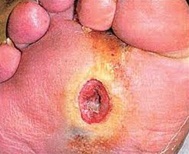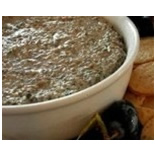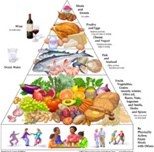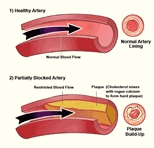Most diabetics do not know what causes high blood pressure. Diabetes is very closely linked to high blood pressure – a condition also known as hypertension. It is estimated that about 75% of adults that have diabetes also have high blood pressure and that a person with diabetes is about twice as likely to get high blood pressure than someone without diabetes.
High blood pressure occurs when arteries become filled with sticky deposits like cholesterol. Cholesterol build up in the arteries decreasing the passageway through which blood can flow. As the passage gets smaller, the heart has to pump harder to push blood through the smaller openings of the arteries, which increases blood pressure.
It may help to think of high blood pressure by thinking of your arteries as a garden hose. If the garden hose becomes filled with sticky dirt, it is more difficult for water to flow through the hose. The pressure ahead of the blockage within the hose increase. However, the pressure Past the blockage is a lot lower and so is the blow of water. So, in a human system the heart feels the pressure resistance, but the blood takes a long time to get to the feet
As such, high blood pressure often leads to poor blood circulation, slow healing, and swelling. Additionally, when a person has high blood pressure, he or she is four times as likely to develop heart disease and has an increased chance of having a stroke. A stroke happens when a part of the brain does not get enough blood to feed and keep those cells alive.
Reading The Numbers
The most common way to get a blood pressure reading is through the use of a cuff or a canvas band that fits around an arm or a leg. The device measures systolic (si-stol-ik) and diastolic (dahy-uh-stol-ik) pressure by pumping air into the cuff until the cuff is snug around the arm or leg.
Systolic pressure is the pressure inside of the artery that builds every time the heart contracts to push blood through the arteries. The diastolic pressure is measured when the heart is resting (after each beat) and filling with blood. When your blood pressure is read, the systolic number is always on the top (the larger number) and the diastolic number is always on the bottom (the smaller number).
How Do I Know if I Have Hypertension?
According to the National Heart, Lung, and Blood Institute (NHLBI) as of 2003:
| Stages Of Blood Pressure |
Systolic (mm Hg) |
Diastolic (mm Hg) |
| Normal |
Less Than 120 |
Less than 80 |
| Pre-Hypertension |
120 to 139 |
80 to 89 |
| Stage 1 Hypertension |
140 to 159 |
90 to 99 |
| Stage 2 Hypertension |
Greater than 160 |
Greater than 100 |
Hypertension is characterized by headaches, dizziness and blurred vision. Because these symptoms are also associated with other conditions, they can be hard to identify as symptoms of high blood pressure. Therefore, it is important to get a regular blood pressure check from your doctor.
Damage From High Blood Pressure (hypertension)
- Kidney Damage – The very small arteries in the kidneys are damaged reducing the removal of waste and toxins from the blood. The waste begin to poison the blood, and the rest of the body. Finally, this leads to kidney failure and dialysis or kidney transplantation or death.
- Heart Disease – Poor blood flow leads to overworking of the heart. This leads to:
- Chest pain (angina)
- Irregular heart rhythm (arrythmia)
- Heart Attack – Can’t catch your breath, and other symptoms.
- Loss of Vision – Blurred vision begins, get worse, leads to blindness. Damage to small blood vessels and pressure inside the eyes.
- Blood Vessel Damage – High blood sugar cause scaring in the lining of blood vessels, this leads to stiffening (arteriosclerosis) and blockage (atherosclerosis) of arteries. These damages bring about more damage such as:
- Mini-strokes – Brief lapse of mental function. This is an early warning that a major stroke is possible.
- Major Stroke – Brain cell death and loss of mental and physical function.
- Aneurysm – A bulge in a brain artery that burst causing life-threatening bleeding in the brain.
- Dementia – Impaired thinking, speaking, reasoning, memory, vision, movement – Caused by stroke and blocked blood flow.
- Mild Cognitive Impairment – Can’t think clearly.
- Seizure in Pregnant Women –
- Aortic Aneurysm – A weakening in the wall of the aortic artery that lead to a bulge and if untreated a burst and death.
The Type 1 diabetic must use enough insulin to take the right amount of sugar from the bloodstream to convert to energy, and cell building material. They must also be very focused on their nutrition and levels of exercise.
Tips to Help Avoid Hypertension
Hypertension is a common condition amongst Diabetics. However, there are some lifestyle changes that you can make in order to reduce your chances of getting high blood pressure:
- minimize salt consumption
- find methods of reducing stress
- stretch
- exercise regularly
- lose weight
- avoid consuming large amounts of alcohol
- don’t smoke
- get regular blood pressure check-ups
If you think that you have hypertension, consult your physician immediately. Addressing hypertension early is the best way to avoid the health risks that are often associated with the condition.
Get to Know Your Heart Rate











 High Blood Pressure (Hypertension)
High Blood Pressure (Hypertension)



Recent Comments